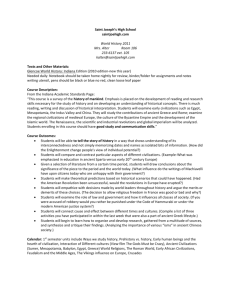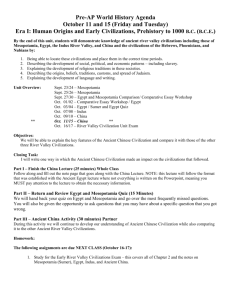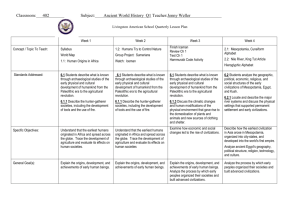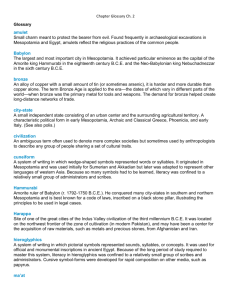Early Civilizations MCs ACH 1: 12. Mayan and Mesopotamia
advertisement
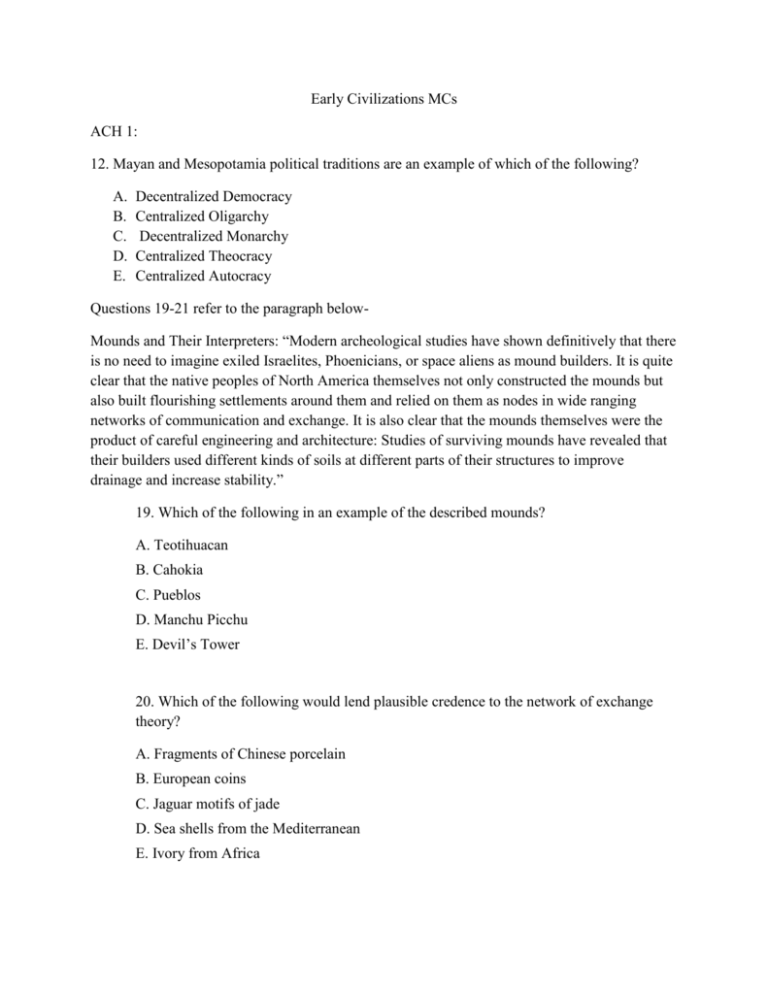
Early Civilizations MCs ACH 1: 12. Mayan and Mesopotamia political traditions are an example of which of the following? A. B. C. D. E. Decentralized Democracy Centralized Oligarchy Decentralized Monarchy Centralized Theocracy Centralized Autocracy Questions 19-21 refer to the paragraph belowMounds and Their Interpreters: “Modern archeological studies have shown definitively that there is no need to imagine exiled Israelites, Phoenicians, or space aliens as mound builders. It is quite clear that the native peoples of North America themselves not only constructed the mounds but also built flourishing settlements around them and relied on them as nodes in wide ranging networks of communication and exchange. It is also clear that the mounds themselves were the product of careful engineering and architecture: Studies of surviving mounds have revealed that their builders used different kinds of soils at different parts of their structures to improve drainage and increase stability.” 19. Which of the following in an example of the described mounds? A. Teotihuacan B. Cahokia C. Pueblos D. Manchu Picchu E. Devil’s Tower 20. Which of the following would lend plausible credence to the network of exchange theory? A. Fragments of Chinese porcelain B. European coins C. Jaguar motifs of jade D. Sea shells from the Mediterranean E. Ivory from Africa 21. What cannot be determined by the above explanation? A. Mound builders were sophisticated B. Large towns grew up around them C. Numerous people gathered there on occasions D. The mounds were built with slave labor E. The mound builders were careful observers of the environment 39. Which society of the world would have been most likely to produce bronze art like the above? A. The Mesopotamians who were the first to produce bronze B. the Hyksos who bronze metallurgy to Egypt C. the Aryans with bronze chariots for warfare D. the Shang who monopolized bronze production E. the Mayans who perfected bronze for use at cutting implements ACH 2: 1. What purpose do scholars believe Paleolithic Venus figures served? A. The figures were the idealized form of beauty among the Paleolithic people. B. The figures represent the powerful queen of the Paleolithic pantheon, Venus. C. The figures reflect a deep interest in the fertility necessary for the generation of the new life. D. The figures represent the attempts of early farmers to insure fertility in their animals. E. The figures demonstrate the power of women as rulers in Paleolithic society 2. Why were women probably the first farmers? A. Women had more free time then men and therefore had more time to experiment B. Women had traditionally been gatherers and therefore understood plants cycles and the effects of sun, rain, and temperature on plant growth. C. Women had more patience and therefore were better suited to a farming life which requires farmers to work hard but then wait for plants to grow. D. Women had mastered raising the animals and now could concentrate on food production. E. Women had smaller hands which were necessary to tend to and harvest crops that were planted on small hills or tight rows. 3. A key geographic difference between ancient Egyptian, Mesopotamian, Harappan, and Chinese society was that A. Egypt and China were more isolated and therefore protected by their environment than were the Mesopotamians or the Harappans. B. While the Egyptians and Mesopotamians were river valley civilizations the Harappans and Chinese had to rely on irrigation to produce ample food. C. The Mesopotamians and Chinese developed vast trading networks, because their rivers were more navigable then the Nile or the Indus Rivers D. The Chinese and Mesopotamians could produce multiple crops each season because of the steady and predictable flooding of their rivers. E. The Egyptians and the Mesopotamians built tall pounded Earth walls to protect their cities because there were few natural barriers to invasion. 4. Which of the following civilizations was governed by a city-state structure? A. Ancient Egypt and Classical Greece B. Ancient Mesopotamia and Ancient Egypt C. Classical Rome and Han China D. Ancient Mesopotamia and Bantu Africa E. Classical Greece and Ancient Mesopotamia 5. Women in which of the following societies enjoyed the greatest amount of personal freedom? A. Ancient Egypt B. Ancient Mesopotamia C. Aryan India D. Classical Greece E. Rome during the republic 40. Which two groups of people had no indigenous tradition of writing? A. South Americans and West Africans B. Mesoamericans and South Americans C. Mesoamericans and North Africans D. Shang Chinese and Harappans E. South Americans and Mesopotamians PEARSON 1: 1. As compared with Paleolithic and Neolithic societies, the agriculture of civilizations A. Totally replaced hunting and gathering B. Permitted migration C. Could not adapt to the wide range of climates and environments D. Limited human exposure to and death rates from diseases E. Changed man’s physical environment 2. How might settlements in the Neolithic Age such as Catal Huyuk affect birth rates? A. There was no affect B. There was no affect on birth rates but a decrease in death rates C. There was an increase in birth rates and death rates D. There was more disease, so the birth rate was low E. There was an increase in birth rates due to security and food supply 3. Compared with river valley cultures in Egypt and Mesopotamia, civilization in China A. Probably developed after civilizations in the Nile Valley and Southwest Asia B. Predates the rise of civilization in both Egypt and Mesopotamia C. Developed simultaneously with Egypt and Mesopotamia D. Did not rely on heavy irrigation, as year-round water plentiful E. Has no verifiable historic origins and left now written records 8. Historically, Pastoral Nomads A. Lived in interspersed with sedentary farmers B. Were rare in Africa and American, but common in Central Asia C. Prevented contacts between the civilized centers of the world D. Had little lasting impact on he development of civilizations E. Lived on the greasy plains of the continents, where sedentary agriculture was extremely difficult 9. In comparison to women in sedentary societies, women in nomadic, pastoral societies A. Had more rights B. Belonged to secret societies C. Were treated equally with their husbands and male counterparts D. Were valued if they could equal males in military courage and accomplishments E. Had fewer rights PEARSON 2: 1. The first truly revolutionary transformation of human society was A. The agricultural Revolution B. The Black Death C. The first Global Age D. The Industrial Revolution E. The Russian Revolution 3. Early civilizations developed A. Through independent patterns of development B. Through intense cultural contacts C. In similar climate zones D. Similar religions E. Through significant but sporadic interactions 4. Periodic nomadic invasions in the early history of Eurasia A. Caused disruptions, but facilitated innovations and prompted synthesis B. Led to the collapse of civilization C. Were easily beaten back by the technologies advanced sedentary peoples D. Caused mass popular migrations throughout Eurasia E. Failed to upset the established political and social patterns of most regions 21. As in the Fertile Crescent, India, and China, the fall of civilizations in the Americas was often due to A. Migrating nomadic invaders B. Crop Collapse C. Famine and disease D. Civil War E. Environmental Disasters 29. Pastoral Nomads from the central Asian steppe who had threatened sedentary civilizations throughout world history included all of these EXCEPT: A. Indo-Europeans B. Hsiung-nu (Huns) C. Bantu D. Scythians E. Turks WORKSHOP: 1. Which of the following occurred as a result of the development of agriculture in societies that previously relied in hunting and gathering? A. Conditions for women improved B. The incidence of disease declined C. Population density increased D. Polytheism disappeared E. Degradation of the environment lessened 40. The spread of Bantu-speaking peoples over southern Africa can be best explained by their A. Conversion the Islam B. Superior naval technology C. Use of cavalry D. Centralized political systems E. Knowledge of agriculture 2008: 1. In most of the early agricultural societies, people had an average life expectancy of 25 years at birth but would live until 50 on average if they managed to reach age 20. These facts primarily reflect A. High rates of infant immortality B. And early age of military service C. Income gaps between wealthy minorities and impoverished masses D. Lack of mass education E. The availability of medicines for adult disease 2. Which of the following is an important legacy of Phoenicians? A. Their monotheistic beliefs inspired Judeo-Christian religion B. Their establishment of centralized bureaucratic state influenced the political structure of the Persian Empire C. Their development of an alphabetic writing system was adapted by the Greeks. D. Their system of legal codification was adopted in its entirety by the Romans E. there army and navy defeated Alexander the Great 5. “If a [noble] man puts out the eye of another [noble] man, his eye shall be put out. “If he breaks another [noble] man’s bone, his bone shall be broken “If he puts out the eye of a man [commoner] or breaks the bone of a [commoner], he shall pay one silver mina. ‘If he puts out the eye of a man’s slave or breaks the bone of a man’s slave, he shall pay one-half of its value.” This excerpt above from the Code of Hammurabi illustrates which of the following about Babylonian society? A. It made provision for the economic well-being of all classes. B. It supported gender equality C. It moved away from reliance on corporal punishment D. It was marked by social inequalities E. The kind was regarded as blessed by divine forces 10. Which of the following describes a major effect of Bantu migrations? A. A single common religion in sub-Saharan Africa B. The diffusion of irrigation techniques to East Africa C. Cultural commonalities in sub-Saharan Africa D. The introduction of banana cultivation to the Sahel E. The political interaction between Bantu-speaking peoples in Indian sailors 36. Which of the following were characteristics of most early civilizations? A. Cave dwellings and stone tools B. Animal herds and portable houses C. Large standing armies and elected governments D. Urban centers, growing populations, and writing systems E. Caravan trade, underground cities, and large ships 70. Which of the following best explains why myths are useful historically? A. They clarify how ancient technology worked B. They analyze how great heroes created the first societies C. They provide insights into the values and traditions of their societies D. They give reasons for the decisions made in military campaigns E. they give detailed plans showing how ancient leaders achieved power
